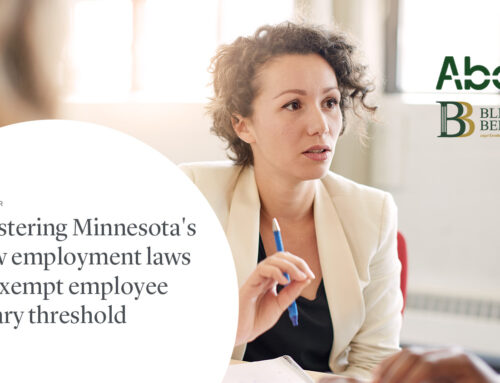To thank Minnesotans who worked on the frontlines during the COVID-19 peacetime emergency, Governor Walz signed the Frontline Worker Pay bill into law on April 29, 2022. The law provides direct payments to eligible frontline workers who apply within the application window. The same legislation also included the Trust Fund Replenishment law, which impacts unemployment tax and assessment rates for taxpaying employers for calendar years 2022 and 2023.
The primary implications for employers include a notice requirement to affected employees and changes related to unemployment rates.
Frontline Worker Pay
What types of businesses are impacted?
Businesses that fall into the “frontline sector” include:
- Long-term care and home care
- Health care
- Emergency responders
- Public health, social service, and regulatory service
- Courts and corrections
- Child care
- Schools, including charter schools, state schools, and higher education
- Food service, including production, processing, preparation, sale, and delivery
- Retail, including sales, fulfillment, distribution, and delivery
- Temporary shelters and hotels
- Building services, including maintenance, janitorial, and security
- Public transit
- Ground and air transportation services
- Manufacturing
- Vocational rehabilitation
Which frontline workers are eligible?
An individual is eligible if the individual:
- Was employed in the frontline sector for at least 120 hours in Minnesota between March 15, 2020, and June 30, 2021;
- During that time period was unable to telework due to the nature of the individual’s work and worked in close proximity to other individuals outside the individual’s household;
- Meets income requirements for at least one of the 2020 or 2021 tax years – if the individual was employed in an occupation with direct COVID-19 patient care responsibilities, an adjusted gross income of less than $350,000 for a married taxpayer filing jointly and less than $175,000 for all other filers, and if the individual was employed in any other occupation, an adjusted gross income of less than $185,000 for a married taxpayer filing jointly and less than $85,000 for all other filers; and
- Did not receive an unemployment insurance benefit payment or serve a non-payable week for more than 20 weeks on a cumulative basis between March 15, 2020, and June 26, 2021.
What is required of frontline sector employers?
Frontline sector employers are required to provide notice to potentially eligible current workers by June 23, 2022, through use of a form approved by the Commissioner of the Department of Labor and Industry, available here: https://www.dli.mn.gov/notice.
Employers must provide notice using the same means used to provide other work-related notices to employees. The notice must be at least as conspicuous as 1) posting a copy of the notice at each work site where workers work and where it may be readily observed and reviewed by all workers at the site; or 2) providing a paper or electronic copy of the notice to all workers.
How do eligible frontline workers receive a payment and where do the funds come from?
To qualify for a payment, an individual must apply to the Commissioner of the Department of Labor and Industry and must certify that the individual meets the eligibility requirements. The application window opened on June 8, 2022 and closes on July 22, 2022. If an application is denied, applicants have 15 days from notice of the denial to appeal the denial. After all applications have been received and the appeals period has ended, allocated Frontline Worker Pay funds will be evenly divided among all eligible frontline workers with approved applications. The individual payments cannot exceed $1,500.
Funding for the payments and administrative costs are appropriated from the general fund, $500,000,000 and $11,650,000, respectively.
Frontline Worker Pay Tax Implications. The law provides that the amount of frontline worker payment received by workers will be excluded from income for Minnesota tax purposes. For federal purposes, the payment will be included in federal adjusted gross income.
Trust Fund Replenishment
What are the tax implications of the law?
Unemployment Base Tax Rate and Assessment. In calendar years 2022 and 2023, the law sets the base tax rate to one-tenth of one percent and the additional assessment to zero percent. In calendar year 2022, the law sets the special assessment to zero percent.
Employer Credits or Refunds. The Commissioner of Employment and Economic Development must credit or refund each taxpaying employer for: 1) any base tax rate amount assessed and paid for calendar year 2022 in excess of the new rate described above; 2) any additional assessment amount assessed and paid for calendar year 2022; and 3) any special assessment amount assessed and paid for calendar year 2022. Employers who already made first quarter 2022 tax payments before the recalculation was complete will likely have a credit on their account. The credit will automatically be carried forward and used to reduce the amount due for second quarter 2022. In the alternative, employers with a credit can also request a refund.
Waiving of Penalties and Interest. The law provides that the Commissioner must waive any interest or penalties accrued on first quarter 2022 taxes due on April 30, 2022, but not paid on or before May 31, 2022.
You can contact any of the employment law attorneys at Blethen Berens – Julia Ketcham Corbett, Beth Serrill, and Alyssa Nelson – for assistance with understanding the implications of the laws and ensuring your organization complies with the notice requirement related to Frontline Worker Pay.


